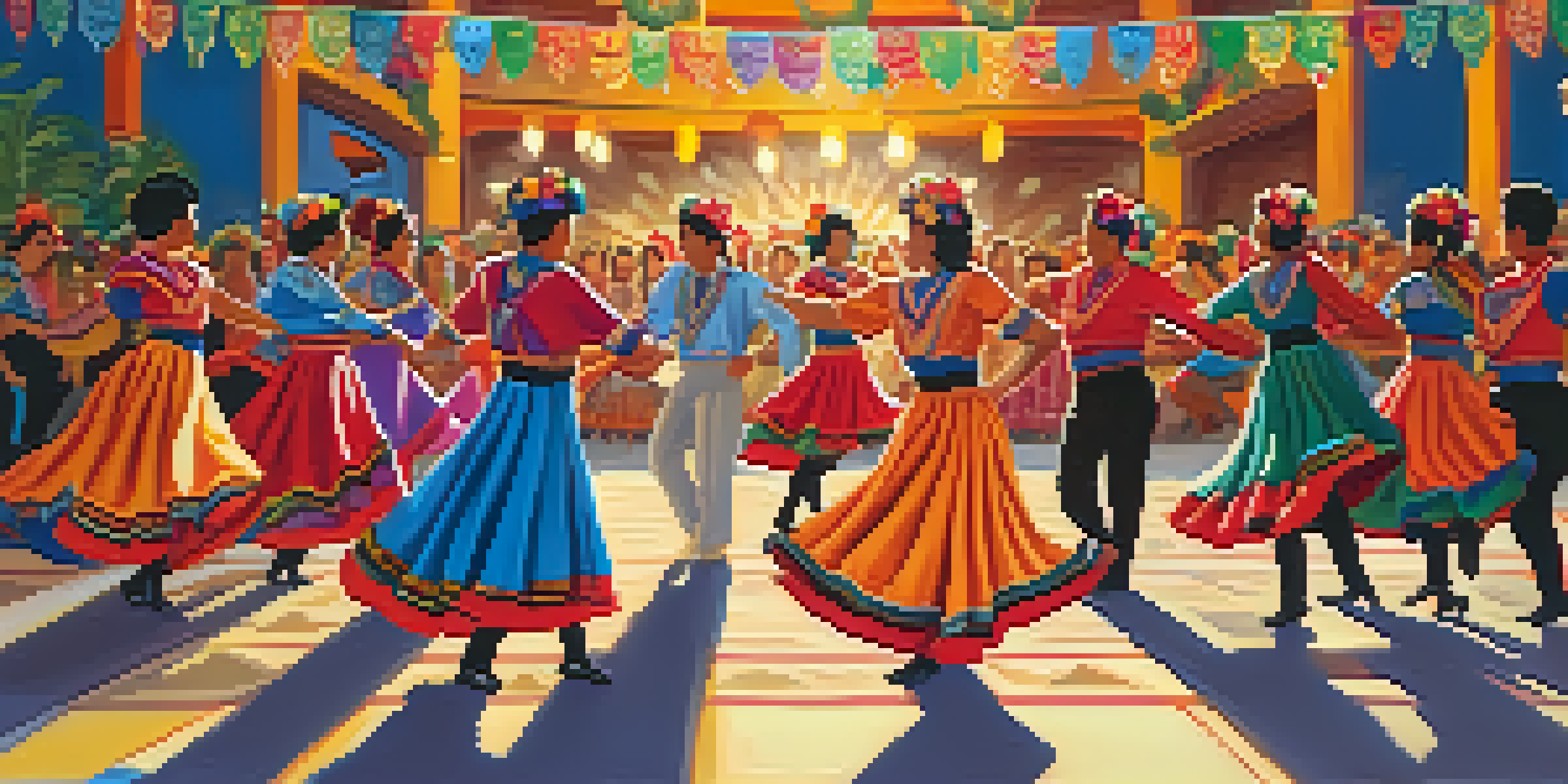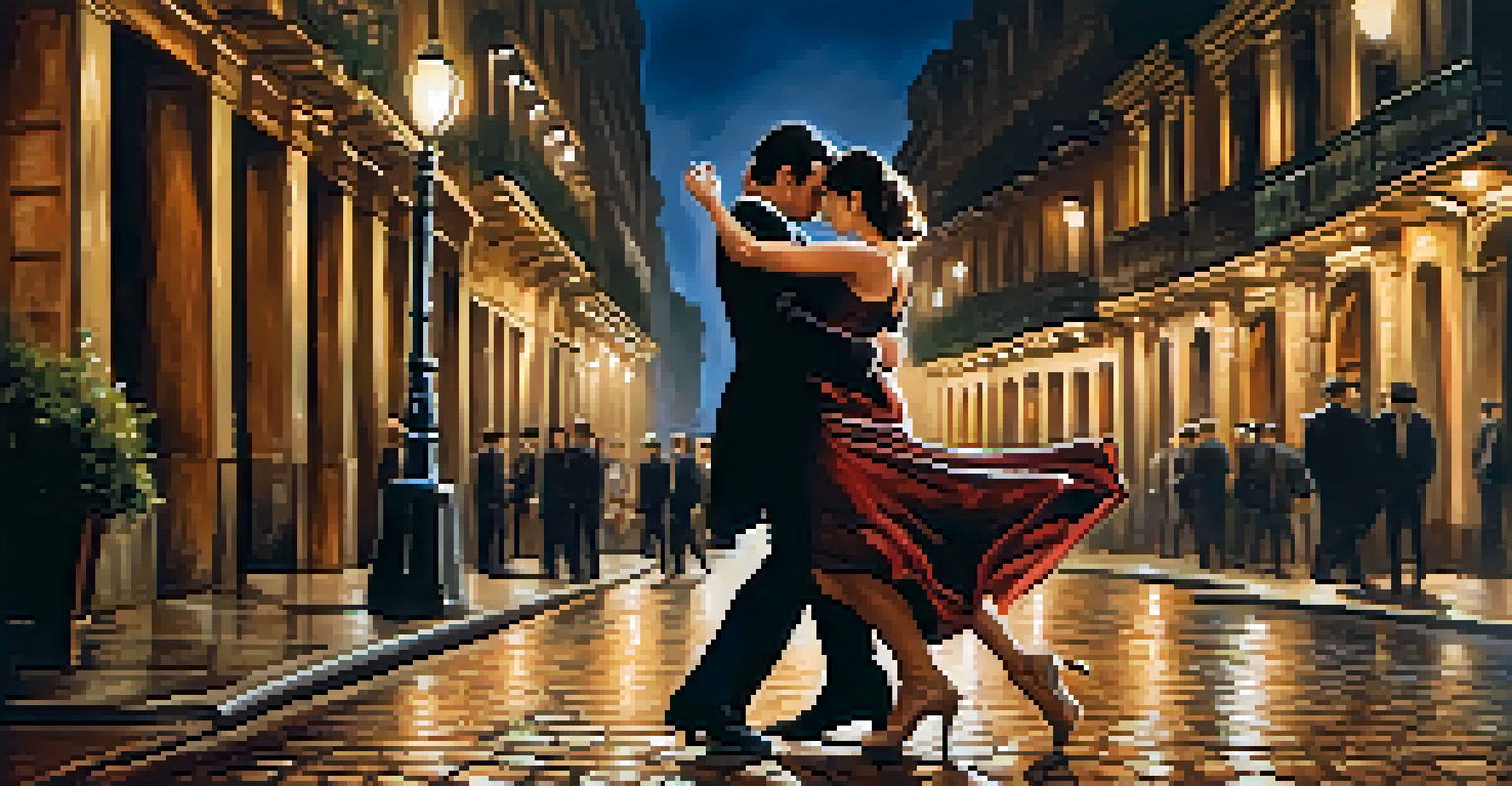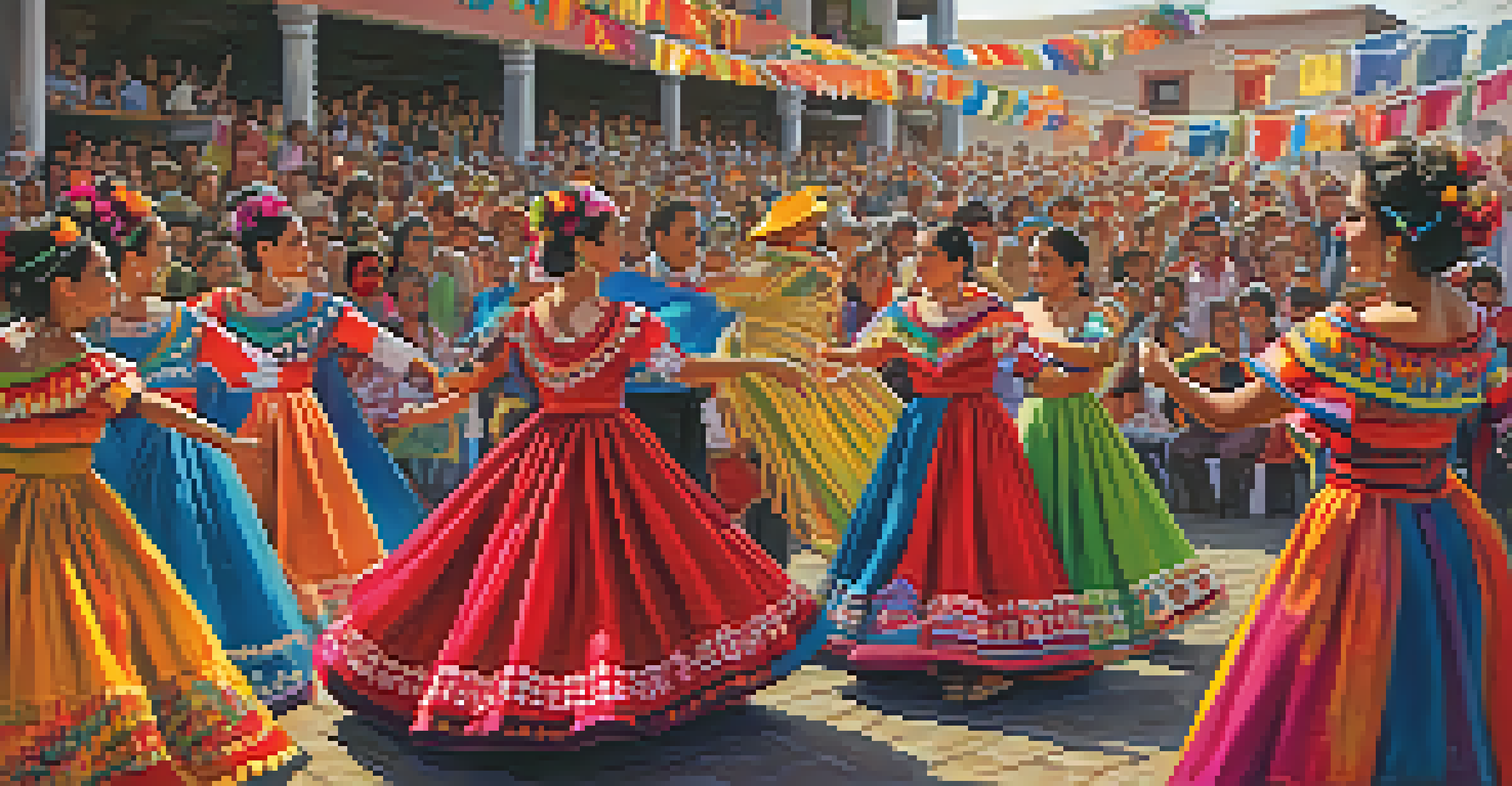Latin American Folk Dance: Rhythms of Cultural Identity

Understanding the Roots of Latin American Folk Dance
Latin American folk dance is a vibrant expression of the region's diverse cultures. Each dance tells a unique story, reflecting the history, struggles, and joys of its people. From the lively tango of Argentina to the spirited salsa of Cuba, these dances are rooted in centuries of tradition and social context.
Dance is the hidden language of the soul.
These dances often emerged from indigenous, African, and European influences, showcasing a rich tapestry of cultural interactions. For instance, the samba, which originated in Brazil, is a perfect blend of African rhythms and Portuguese melodies. This fusion not only highlights the complexity of cultural identity in Latin America but also how dance serves as a unifying force.
Moreover, folk dance is a way of preserving heritage, with many communities holding festivals to celebrate their traditions. Through these gatherings, generations pass down the stories and techniques, ensuring that the rhythm of their ancestors continues to echo in the present.
Key Characteristics of Latin American Folk Dances
Latin American folk dances are characterized by their energetic movements, colorful costumes, and distinct music styles. Each dance often incorporates specific steps and formations that are unique to its cultural background. For example, the Cumbia, originating from Colombia, features a mix of slow and fast beats that encourages playful interactions between dancers.

Costumes play a significant role as well, often reflecting the culture’s history and identity. Vibrant dresses with intricate patterns and bright colors are not just for aesthetics; they symbolize pride in one’s heritage. The visual spectacle enhances the storytelling aspect of the dance, making performances captivating to watch.
Cultural Roots in Dance
Latin American folk dance reflects the diverse cultural influences and histories of the region, serving as a unifying force among communities.
Music is the heartbeat of these dances, with instruments ranging from guitars and maracas to drums and flutes. The rhythm often dictates the dance style, with lively beats encouraging fast-paced movements, while slower melodies allow for more graceful expressions. Understanding these elements deepens our appreciation for the art form.
The Role of Folk Dance in Cultural Preservation
Folk dance serves as a vital tool for cultural preservation in Latin America. In a rapidly globalizing world, these dances help maintain a sense of identity and belonging among communities. Festivals and local celebrations often showcase these dances, allowing younger generations to connect with their roots.
Folk dance is a mirror of the culture that creates it.
Educational programs and workshops are increasingly being organized to teach folk dance. These initiatives not only help preserve the techniques and history but also foster a sense of community. Participants bond over shared experiences, learning the significance of their cultural heritage through dance.
Additionally, folk dance has found its way into modern interpretations, bridging the gap between traditional and contemporary. This evolution ensures that while the essence of the dance remains intact, it continues to resonate with younger audiences, keeping the cultural flame alive.
Famous Latin American Folk Dances and Their Stories
Among the myriad of Latin American folk dances, some have gained international fame. The tango, originating in the working-class neighborhoods of Buenos Aires, tells tales of love, loss, and passion. It has evolved into a global dance phenomenon, yet its roots remain deeply embedded in Argentine culture.
Similarly, the Mexican folklórico dance showcases the country's rich history, with each region having its own distinct style and costume. These dances often celebrate historical events or traditional tales, making them a living history lesson for participants and spectators alike.
Preserving Heritage Through Dance
Folk dance acts as a vital tool for cultural preservation, connecting younger generations to their roots through festivals and educational programs.
The Brazilian samba, with its infectious rhythm and energetic movements, epitomizes the spirit of Carnival. It's a dance that brings people together, transcending social classes and uniting them in celebration. The stories behind these dances are as vibrant as the dances themselves.
The Impact of Folk Dance on Community Identity
Folk dance plays a crucial role in shaping and reinforcing community identity in Latin America. These dances foster a sense of pride and belonging, allowing individuals to connect with their cultural heritage. Participating in folk dance can be a powerful reminder of one's roots, enhancing community bonds through shared experiences.
Moreover, dance often serves as a medium for social commentary. Through movement, dancers can express their views on societal issues, history, and identity. This dynamic interplay between dance and community allows for a deeper understanding of the cultural landscape.
In many regions, folk dance is also used as a means of protest or resistance, highlighting social injustices. By showcasing their traditions, communities assert their identity and resilience, often using dance as a platform for advocacy. Thus, folk dance becomes not just a performance but a powerful statement of cultural pride.
Modern Influences on Traditional Folk Dance
As global influences permeate every aspect of life, traditional folk dance is not immune to change. Contemporary styles and fusions have emerged, often blending traditional steps with modern music and influences. For instance, the rise of urban dance styles has inspired some regions to incorporate hip-hop elements into their folk performances.
While some purists may resist these changes, many see them as a natural evolution of culture. This blending allows folk dance to remain relevant, attracting younger audiences who may not connect with traditional forms. By evolving, these dances can continue to thrive in an ever-changing cultural landscape.
Modern Evolution of Folk Dance
Traditional folk dance is evolving by incorporating contemporary styles, ensuring its relevance and appeal to younger audiences while celebrating cultural identity.
This modern twist on folk dance also facilitates cross-cultural exchanges, allowing for collaboration between artists from diverse backgrounds. Such interactions enrich the dance forms and foster greater appreciation for the myriad of influences that shape Latin American identity.
Celebrating Latin American Folk Dance Today
Today, Latin American folk dance is celebrated worldwide, with festivals and competitions showcasing its richness. Events such as the Festival Internacional de Danza Folklórica in Mexico draw participants from various countries, creating a vibrant tapestry of dance and culture. These gatherings not only promote folk dance but also encourage cultural exchange.
Social media has also played a significant role in the resurgence of interest in folk dance. Platforms like Instagram and TikTok allow dancers to share their performances, reaching global audiences and inspiring new generations. As a result, the visibility of these dances has increased, sparking curiosity and participation.

Moreover, educational institutions are incorporating folk dance into their curricula, ensuring that future generations appreciate and understand their cultural heritage. By celebrating folk dance today, we honor the past while paving the way for its future.